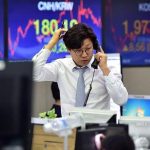This post will build upon my previous post with the Cobra equation. In that post, I gave a model showing that the Fed is completely behind the curve of the business cycle. The Fed should not be raising rates at this point in the business cycle.
When to Normalize in Theory
In the model, aggregate profit rates have a somewhat circular movement through a business cycle. I say somewhat because in other business cycles, the circular movement looks more like a bouncing ball off of the effective demand limit.
In the green portion of the cycle, aggregate profit rates are increasing. There is broad momentum to expand utilization of labor and capital. It is the best time for interest rates to get on a path to normalization. The economy can withstand the good medicine of normalizing interest rates because of the momentum of increasing profit rates.
If US interest rates are too low or too high in the green area, global imbalances will grow to some extent.In the present business cycle, inflation and the labor market looked weak, interest rates were kept low. Even though the economy seems weak and fragile in the green area, the underlying profit momentum drives economic developments and possibly imbalances. Normalizing interest rates are meant to moderate those imbalances.
So the Fed decided not to normalize interest rates because the economy seemed weak and partly because economists like Paul Krugman said the Fed needed to wait for inflation. But global debt accumulated, even emerging market debt, because interest rates were not normalizing in the US.
The accumulated debt is a problem that hinders growth. Apart from there just being more debt, much of the debt in emerging markets is in US dollars. So if interest rates are normalizing in the US, there is a control over too much US dollar debt developing in emerging markets. That is a good thing, because now we see greater problems as the cycle begins to tighten with monetary policy and peaked profit rates.













Leave A Comment